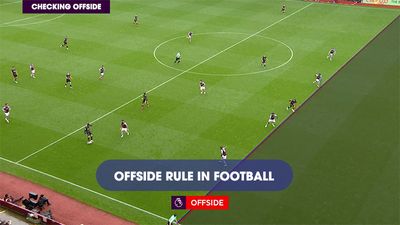Quick Betimate
Popular Leagues
Other Leagues
Offside rule: Decoding Controversial Law in Football

Football is a game that captivates millions of fans around the world with its thrilling moments and nail-biting matches. To truly appreciate the game, it is essential to understand its rules, including the offside rule.
In the world of football, the offside rule plays a significant role in ensuring fair play and maintaining the balance between attackers and defenders. It prevents players from gaining an unfair advantage by positioning themselves incorrectly during an attacking move. Understanding what is offside in football is vital for players, coaches, referees, and fans alike.
Understanding the Offside Rule
Offside Rule in football
What is the Offside Rule?
The offside rule in football is a fundamental regulation in football that aims to prevent players from gaining an unfair advantage by being in an advantageous position in relation to the opposing team's defense. Essentially, it ensures that attacking players are not in an offside position when the ball is played to them.
How Does Offside Occur?
To understand what is offside in football, we must first examine the elements involved in its occurrence. When a pass is made to an attacking player, they must be mindful of their position in relation to the last two defenders—usually the last outfield player and the goalkeeper. If an attacking player is ahead of the second-to-last defender at the moment the ball is played to them, they are considered to be in an offside position.
Offside Offense
Being in an offside position can lead to various offenses in football, often causing confusion and controversy. One of the primary reasons for an offside offense is when a player receives and plays the ball while being in an offside position at the moment it is played to them by a teammate. This situation is referred to as interfering with play.
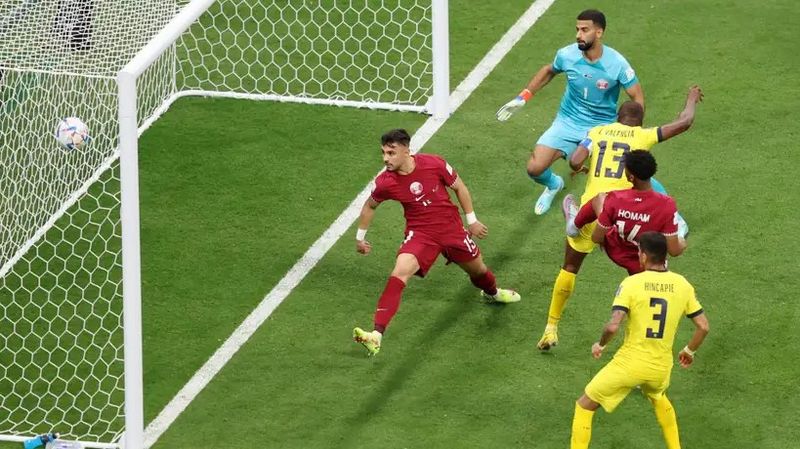
An example about offside
Additionally, a player can break the offside rule in football ruleby interfering with an opponent in several ways:
- Obstructing the opponent's line of vision: If a player obstructs an opponent's line of vision, preventing them from playing or being able to play the ball, it constitutes an offside offense.
- Challenging an opponent for the ball: Engaging in a challenge with an opponent for the ball while in an offside position is also considered an offside offense.
- Impact on opponent when attempting to play the ball: If a player in an offside position clearly attempts to play the ball, and in doing so, impacts an opponent, it results in an offside offense.
- Actions impacting the opponent's ability to play the ball: Making an obvious action that significantly hinders an opponent's ability to play the ball is another way to commit an offside offense.
Furthermore, a player can be deemed offside if they were initially in an offside position when a teammate plays the ball, and it subsequently rebounds or deflects off the post, crossbar, or an opponent before reaching the player or if the ball is deliberately saved and rebounds to them.
These various scenarios highlight the complexities of offside offenses in football and the need for careful interpretation and decision-making by officials. The intricacies involved can often spark debates and discussions among players, coaches, and fans alike.
Offside Position
What is an Offside Position?
To understand what is offside in football, define offside position is necessary. An offside position refers to the situation in which an attacking player is closer to the opponent's goal line than both the ball and the second-to-last defender at the moment the ball is played to them. It's important to note that being level with the second-to-last defender is not considered an offside position, as the player is not ahead of them.
Passive and Active Offside Positions
Within the realm of offside positions, two distinct types exist: passive and active. A player is in a passive offside position if they are not actively involved in the play when the ball is played to them. On the other hand, a player is in an active offside position if they are interfering with an opponent or gaining an advantage from their position when the ball is played to them.
Exceptions to Offside Positions
There are certain situations in which an offside offense is not called, despite a player being in an offside position. One such exception is when the player receives the ball directly from a goal kick, corner kick, or throw-in. Additionally, a player cannot be offside when they are in their own half of the field during the moment the ball is played to them.
Historical Perspective on Offside
Evolution of the Offside Rule
The offside rule in football has a long and intriguing history, dating back to the early days of football. In its early form, the rule was simple and straightforward. Any player who received the ball while being ahead of the last defender was deemed offside. This rudimentary rule provided a basic framework for the game but left room for ambiguity and interpretation.
As the game evolved and tactics became more refined, there arose a need for a more precise offside rule. The introduction of the concept of the "three-player" rule in the 19th century was a pivotal moment. According to this rule, for a player to be considered offside, they needed to be ahead of at least three opposing players at the moment the ball was played to them. This modification aimed to balance attacking opportunities while ensuring fair play.
Changes and Modifications Over the Years
Throughout the 20th century, "what is the offside in football" continued to evolve to address various challenges faced by referees, players, and coaches. In 1925, the "two-player" rule was introduced, reducing the number of opponents a player had to be ahead of to be considered offside. This change aimed to encourage more attacking play and open up the game.
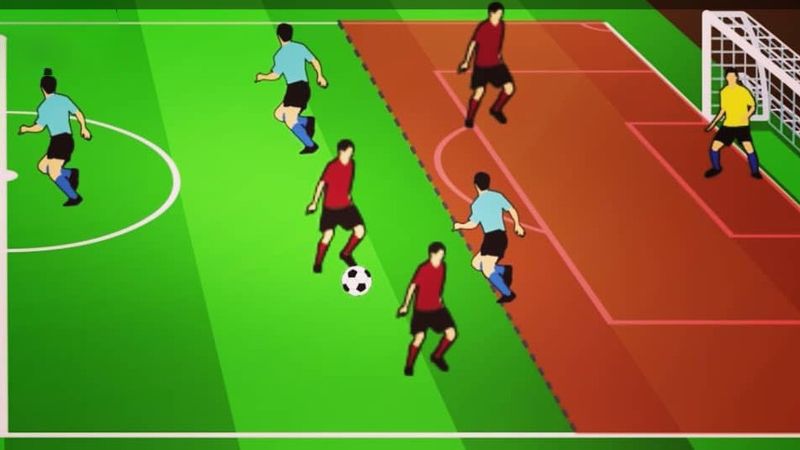
Offside had changes and modifications over the years
Over time, different leagues and football associations adopted slightly different variations of the offside rule, leading to inconsistencies in its application. This prompted efforts to standardize the rule globally, resulting in the 1990 revision by the International Football Association Board (IFAB). The new rule stated that a player would be offside if they were nearer to the opponents' goal line than both the ball and the second-to-last defender at the moment the ball was played to them.
The most significant recent change to the offside rule occurred in 2005 when the IFAB decided that passive offside positions would no longer be considered offenses. This meant that a player in an offside position who did not actively participate in the play, such as interfering with an opponent or gaining an advantage, would not be penalized. This change brought more clarity and fairness to the game, reducing the number of contentious decisions.
Influential Cases and Their Impact on the Rule
Several influential cases have shaped the offside rule throughout history, leading to modifications and refinements. One notable case is the "Geoff Hurst's Goal" in the 1966 FIFA World Cup final between England and West Germany. In the closing moments of the game, Hurst scored a crucial goal, and controversy ensued regarding whether he was offside or not. The goal stood, and England went on to win the World Cup. This incident sparked debates and discussions about the interpretation of the offside rule, ultimately influencing subsequent revisions.
Another influential case that impacted the offside rule occurred in 2004 during a UEFA Champions League match between Barcelona and Chelsea. The game saw a controversial disallowed goal by Chelsea's striker, Didier Drogba, due to an offside decision. The incident ignited discussions about the precision and fairness of the offside rule, prompting further examination and modifications.
The introduction of Video Assistant Referee (VAR) technology in recent years has also influenced the offside rule. VAR allows referees to review decisions more effectively, reducing the margin for error. However, VAR decisions related to offside have faced criticism due to the level of precision involved, with some arguing that the technology has made the game too pedantic.
Offside Decision Making
Football is a game filled with excitement, goals, and thrilling moments. However, amidst all the action, there are instances where the assistant referee's (linesman's) decision-making plays a crucial role. One such decision is determining if a player is in an offside position.
Role of the Assistant Referee (Linesman)
The assistant referee, commonly referred to as the linesman, is an integral part of the officiating team in a football match. Their primary role is to assist the referee in making various decisions throughout the game, including offside calls. Positioned along the touchline, the linesman keeps a watchful eye on the players' positioning and movement to ensure fair play.
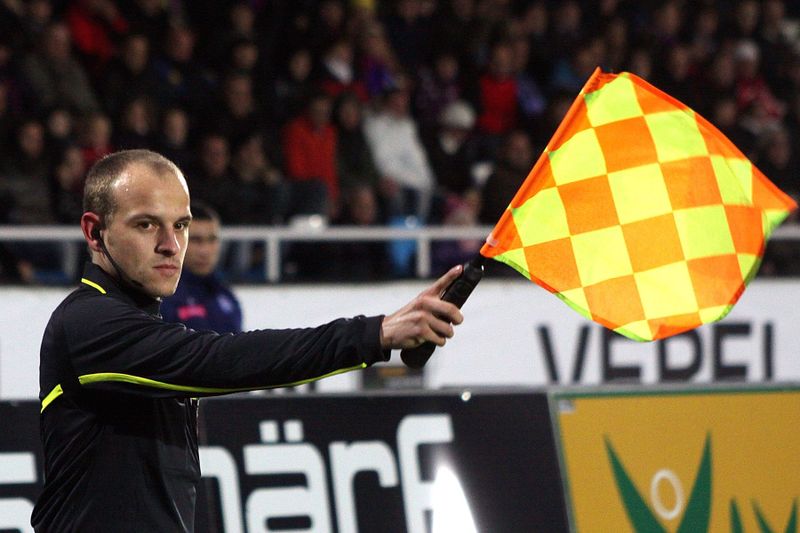
Assistant Referee plays an important role in deciding offside
The linesman's main responsibility when it comes to offside decisions is to determine whether an attacking player is in an offside position at the moment the ball is played. They accomplish this by carefully observing the players' positions relative to the second-to-last defender, excluding the goalkeeper, at the time the ball is passed or played to them. If the linesman deems the player to be in an offside position, they raise their flag to indicate the infringement.
Factors Considered in Making an Offside Decision
Making an offside decision is not a simple task and requires the assistant referee to consider several factors before reaching a verdict. Here are some crucial factors that come into play:
- Position of the Player: The assistant referee closely monitors the position of the attacking player when the ball is played. If any part of the player's body, typically excluding the arms, is beyond the second-to-last defender at that moment, they may be considered offside.
- Timing of the Pass: The assistant referee must accurately judge the precise moment the ball is played by the passer. This timing is crucial in determining if the attacking player was in an offside position at that specific instant.
- Active Involvement: Another factor the assistant referee considers is whether the offside player is actively involved in the play. If the player, while in an offside position, interferes with an opponent or gains an advantage from their position, the assistant referee is more likely to flag the infringement.
- Intent: The assistant referee must discern the attacking player's intent when they receive the ball. If the player intentionally positions themselves in an offside position to gain an unfair advantage, it may result in an offside call.
Challenges and Controversies in Offside Calls
Offside decisions in football often spark debates, generate controversies, and even alter the course of a match. Several challenges arise when it comes to making accurate offside calls:
- Marginal Offside: Determining offside accurately becomes challenging when the margin between the attacking player's position and the second-to-last defender is minimal. In such instances, the assistant referee must make a split-second decision that could have significant consequences for the game.
- Human Error: Offside decisions are susceptible to human error. Despite their best efforts, assistant referees can misjudge the timing of the pass or player positions, leading to incorrect offside calls. Such errors can create frustration among players, coaches, and fans.
- VAR Interventions: The introduction of Video Assistant Referee (VAR) technology has added another layer of complexity to offside decisions. VAR allows for a meticulous review of offside incidents using multiple camera angles, slowing down the footage to pinpoint the exact moment
- the ball is played. However, the implementation of VAR has not been without its own controversies, as debates persist regarding the precision and subjectivity of its decisions.
- Offside Traps: Defending teams often employ tactics such as the offside trap to catch attacking players in an offside position. By moving their defensive line forward in unison, they attempt to lure the attackers into an offside position. This strategy can create confusion for assistant referees, as they must carefully observe the movements of both the attacking and defending players.
- Fan Reactions: Controversial offside decisions can incite strong reactions from fans, sometimes leading to heated debates and accusations of bias. The intense emotions surrounding these moments can overshadow the overall spirit of fair play.
When is offside not an offence?
In the fast-paced and competitive game of football, the offside rule plays a crucial role in maintaining fairness and preventing strategic advantages. However, like any rule, there are exceptions to the offside rule that allow for unique circumstances to be considered. These exceptions ensure that the game remains exciting and unpredictable, while still adhering to the fundamental principles of fair play.
Exceptions for Goalkeepers
When it comes to goalkeepers, the offside rule is relaxed to accommodate their role as the last line of defense. In certain situations, a player will not be considered offside if they receive the ball directly from a goal kick, a corner kick, or a throw-in. This exception acknowledges the fact that goalkeepers have limited options for distributing the ball quickly and efficiently. By allowing them to bypass the offside rule in these specific scenarios, it promotes a more fluid and dynamic style of play.
Additionally, if a player is in an offside position but not actively involved in the play, the offside rule does not apply. For example, if a teammate shoots the ball towards the goal, and an offside player standing in front of the goalkeeper does not interfere with the goalkeeper's line of sight or movement, the goal will still be considered valid. This exception prevents players from gaining an unfair advantage solely based on their positioning.
Exceptions for Throw-ins, Corner Kicks, and Goal Kicks
Throw-ins, corner kicks, and goal kicks are all set-piece situations that provide unique exceptions to the offside rule. During a throw-in, a player cannot be offside. This means that if a teammate throws the ball to them and they are in an offside position, they will still be allowed to play the ball. This exception ensures that the game flows smoothly during these restarts and prevents unnecessary stoppages.
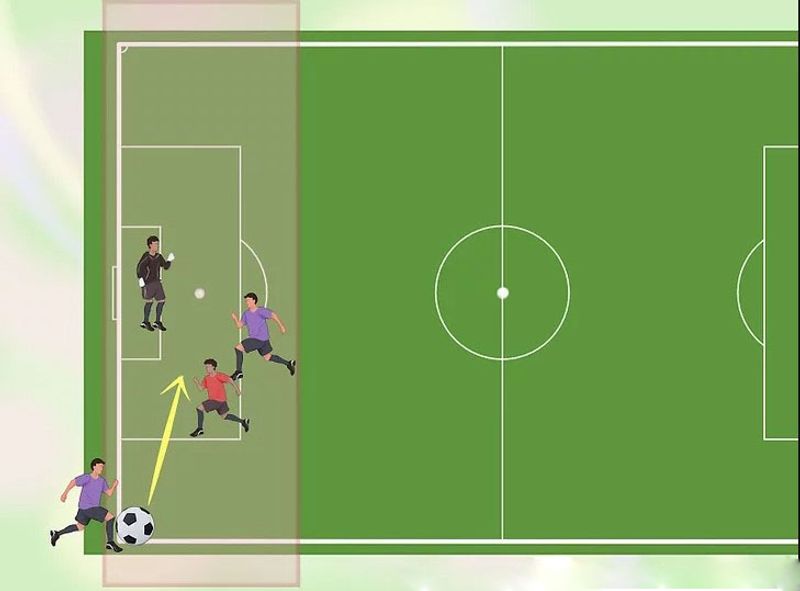
Exceptions in the Offside Rule
Similarly, during a corner kick, the offside rule does not apply until the ball is played by another player. This means that attackers can position themselves strategically in the penalty area, even if they are in an offside position at the moment of the kick. Once the ball is in play, however, the offside rule comes into effect, and players must adhere to its requirements.
When it comes to goal kicks, the offside rule is temporarily suspended until the ball has left the penalty area. This allows defenders to quickly distribute the ball without the fear of their attacking teammates being caught offside. Once the ball has exited the penalty area, the offside rule is reinstated, and players must once again abide by its stipulations.
Deliberate Pass by an Opponent
One intriguing exception to the offside rule involves a deliberate pass by an opponent. If an opposing player intentionally plays the ball towards their own goal, and it is received by an offside teammate, the offside offense is not considered. This exception is in place to prevent defenders from taking advantage of the offside trap by deliberately playing the ball to an offside teammate, thus penalizing the attacking team unfairly.
However, it's important to note that the pass must be deliberate. If the ball deflects off an opponent or is played unintentionally, the offside rule will still apply. This exception highlights the intentionality behind the pass and ensures that the offside rule remains fair and objective.
VAR: A Game-Changing Technology
What is Video Assistant Referee (VAR)?
Video Assistant Referee (VAR) is a sipport tool for officials that has revolutionized the world of football. It has transformed the way the game is officiated, bringing about significant changes and improvements. VAR employs advanced video analysis to assist referees in making accurate decisions, particularly in offside situations. This innovative technology has had a profound impact on the sport, benefiting players, officials, and fans alike.
How VAR is used in offside decisions?

Video Assistant Referee (VAR) system
Offside decisions have long been a subject of contention in football matches. The introduction of VAR aims to bring greater accuracy and fairness to these decisions. When an offside incident occurs, the on-field referee and the VAR team work collaboratively to review the incident using video footage. The process involves careful analysis of multiple camera angles to determine if a player was in an offside position at the time the ball was played. This review process allows officials to make more informed decisions and helps ensure that the correct call is made.
Impact of VAR on offside calls
Enhanced Decision-Making
With the introduction of VAR, football has entered a new era of decision-making. The use of video technology allows officials to review critical incidents and make more accurate judgments. In offside decisions, the ability to examine the footage from multiple angles enables referees to identify even the slightest margins and determine whether an attacker was in an offside position. This enhanced decision-making process has brought more precision to the game and reduced the likelihood of incorrect calls.
Increased Fairness and Transparency
VAR has significantly contributed to the fairness and transparency of offside decisions. In the past, there were instances where incorrect calls or missed offside incidents affected the outcome of matches. VAR's implementation ensures that such errors are minimized, as the technology leaves little room for ambiguity. The use of video footage allows officials to analyze the incident thoroughly, ensuring that the correct decision is reached. This increased fairness and transparency have instilled greater trust in the officiating process among players, coaches, and fans.
Adjusting to New Offside Interpretations
While VAR aims to make offside decisions more accurate, it has also introduced new challenges in terms of interpretation. The technology allows officials to scrutinize every moment leading up to a goal-scoring opportunity, including the positioning of players in offside situations. This has led to stricter enforcement of the offside rule and instances where goals have been disallowed due to players being marginally offside. As a result, players and coaches have had to adapt their strategies and timing to avoid falling foul of these revised interpretations.
Delays and Disruption
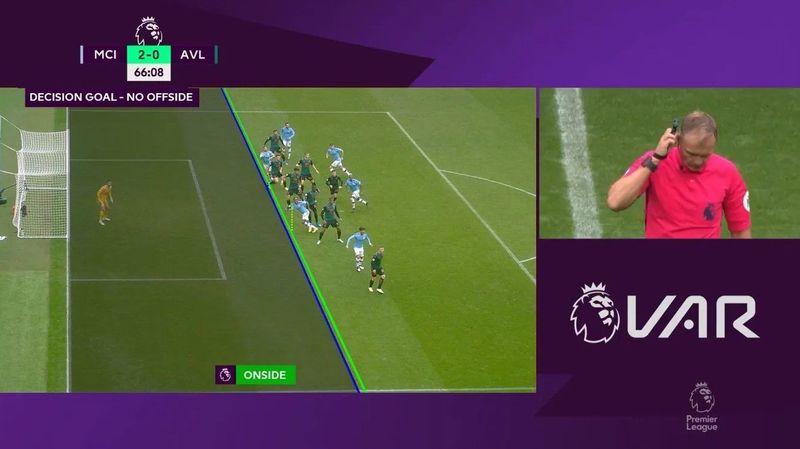
VAR help enhance decision-making but also cause delays and disruption
One of the most significant criticisms of VAR in offside decisions is the potential for delays and disruptions to the flow of the game. As referees consult with the VAR team and review video footage, the natural rhythm of the match can be interrupted, leading to frustration among players and fans. However, efforts are being made to streamline the process and reduce these interruptions, ensuring that VAR has a minimal impact on the overall pace of the game.
Controversies and Subjectivity
Despite the intention to improve accuracy, VAR has not been without its share of controversies. Offside decisions, in particular, have sparked debates due to the subjectivity involved in judging marginal calls. The use of technology may provide more precise measurements, but it cannot eliminate the element of interpretation entirely. There have been instances where fans, players, and pundits have questioned the VAR decisions, even in offside calls. The ongoing discussions around the implementation and application of VAR demonstrate the complexities involved in finding the right balance between technology and human judgment.
Education and Familiarity
As VAR continues to be integrated into football competitions worldwide, there is a growing need for education and familiarity with the system. Players, coaches, and fans must understand the intricacies of VAR and how it impacts offside decisions. By providing clear guidelines and disseminating information, authorities can ensure that everyone involved in the game is well-informed about the technology and its implications. This knowledge fosters a more nuanced understanding of offside calls and helps minimize confusion or misunderstandings.
VAR's Evolution and Future Developments
VAR is still a relatively new addition to football, and it continues to evolve and undergo refinements. As technology advances and new insights emerge, there will likely be further developments in the way VAR is implemented and utilized in offside decisions. The football community, including players, officials, and fans, must adapt to these changes and embrace the opportunities that VAR presents. With ongoing discussions and improvements, VAR has the potential to enhance the game's integrity and elevate the accuracy of offside decisions even further.
Offside Strategies and Tactics in Football
Football is a game of strategy and tactics, and one aspect that teams focus on is the offside rule. The offside rule is designed to prevent attacking players from gaining an unfair advantage by positioning themselves in an offside position. It adds an element of challenge and requires careful coordination and strategy from both defenders and attackers.
Role of the Offside Trap
Offside trap
The offside trap is a defensive strategy used by teams to catch opposing players in an offside position. It involves the defenders moving forward in unison, playing a high defensive line, and timing their movements perfectly to catch attacking players offside. By employing the offside trap effectively, teams can disrupt the opponent's attacking rhythm and create turnovers in possession.
Timing and Coordination of Defenders
Timing and coordination are crucial aspects of executing the offside trap successfully. Defenders must have a deep understanding of their teammates' positioning and movement patterns. They need to communicate effectively, using visual and verbal cues to ensure everyone moves forward in unison. If one defender mistimes their movement, it can leave gaps in the defensive line and allow attackers to exploit the space behind.
Offensive Strategies to Exploit or Overcome the Offside Rule
While the offside rule primarily favors defenders, attacking teams have devised various strategies to exploit or overcome its limitations. Let's explore some of these offensive tactics:
- Quick Short Passes: By playing quick short passes, attacking teams can keep the ball moving and prevent defenders from getting into a well-organized offside trap. This strategy requires excellent technical skills and intelligent movement off the ball.
- Fast and Agile Strikers: Having fast and agile strikers who can make quick bursts of acceleration can be an effective way to overcome the offside trap. Their speed and ability to time their runs well can catch defenders off guard and create scoring opportunities.
- Dropping Deep: Attacking players can intentionally drop deep into their own half, luring the defenders out and breaking their defensive line. This strategy can create space behind the defense for other attackers to exploit.
- False Runs: Players can make false runs to confuse defenders and disrupt their offside trap. By making a run towards the defenders and then quickly changing direction, attackers can create confusion and open up spaces for their teammates.
- Using Width: Exploiting the width of the pitch can be an effective way to stretch the defensive line and create gaps. Attacking players can make runs along the flanks, forcing the defenders to adjust their positions and potentially breaking the offside trap.
- Set-Piece Variations: During set-pieces, teams can use variations in their positioning and movement to confuse defenders. By introducing unexpected movements or decoy runners, attackers can disrupt the defensive line and create scoring opportunities.
Common Misconceptions About Offside
Clarifying Common Misunderstandings
Offside: What Does It Really Mean?
Offside is a fundamental rule in football designed to maintain fairness and prevent teams from gaining an unfair advantage by positioning players in offside positions. The offside rule states that a player is in an offside position if they are nearer to the opponent's goal line than both the ball and the second-to-last defender (typically the last outfield player) at the moment the ball is played to them. However, being in an offside position does not necessarily mean a player has committed an offside offense.
Timing is Everything: The Offside Offense
A common misconception is that simply being in an offside position constitutes an offense. However, according to the Laws of the Game, an offside offense only occurs when a player is involved in active play by either interfering with an opponent or gaining an advantage from being in that position. In other words, if a player in an offside position is not actively participating in the play, the offside rule does not apply.
Understanding the Importance of "Interfering with an Opponent"
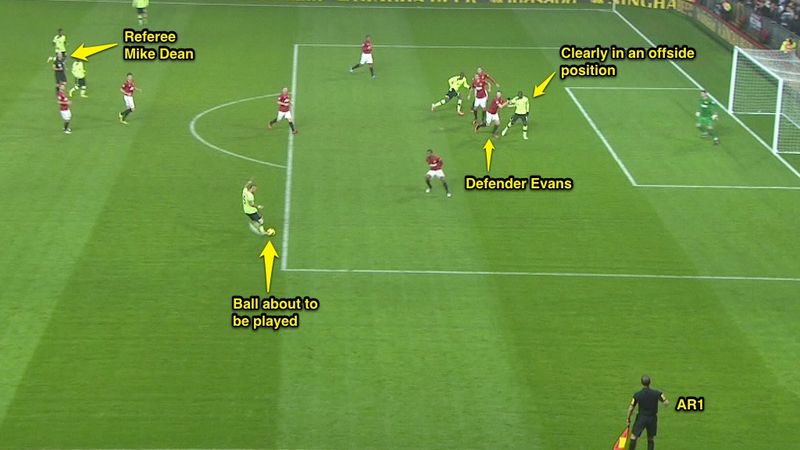
Offside and Interfering With An Opponent
Another misconception is the confusion surrounding what it means to "interfere with an opponent." Interfering with an opponent refers to situations where an offside player impacts the ability of an opponent to play the ball or gain an advantage. This can include actions such as obstructing the goalkeeper's line of sight, blocking the path of an opponent, or making a move that distracts or confuses the defending team. It's crucial to recognize that interfering with an opponent is a subjective decision made by the referee based on the specific circumstances of each situation.
The Role of Passive Offside Players
Passive offside players, who are in an offside position but not directly involved in the play, do not commit an offside offense. These players can potentially impact the decision-making of the defending team, leading to confusion among both players and spectators. However, it's essential to note that as long as the passive offside players do not become active, they are not considered to have committed an offside offense.
The Importance of Receiving the Ball from a Teammate
Some misconceptions arise from a lack of understanding of the offside rule's intricacies. One such misconception is that players can be in an offside position when receiving the ball directly from a goal kick, corner kick, or throw-in. However, according to the Laws of the Game, a player cannot be offside when receiving the ball directly from these restarts. The offside rule only applies when a player receives the ball directly from a teammate.
The Myth of the Perfectly Timed Run
Another common misconception is the belief that a player's perfectly timed run can never result in an offside offense. While a well-timed run can certainly give a player an advantage, it is crucial to remember that being in an offside position at the moment the ball is played to them still constitutes an offside offense. Timing alone does not exempt a player from the offside rule.
Examples of Situations Often Mistaken for Offside
Scenario 1: The Ball Played Backward
One situation often mistaken for offside is when the ball is played backward to an attacking player who appears to be in an offside position. However, if the ball is played backward intentionally by a teammate, the offside rule does not apply. In this case, the attacking player can continue their involvement in the play without committing an offside offense.
Scenario 2: The Player Behind the Ball
In certain situations, a player might appear to be in an offside position but is actually behind the ball when it is played to them. Being behind the ball at the moment of the pass negates any offside offense, as the player is not gaining an unfair advantage by being closer to the opponent's goal line.
Scenario 3: The Defending Player's Touch
Another scenario that can cause confusion is when a defending player intentionally plays the ball but it inadvertently reaches an attacking player who appears to be in an offside position. If the ball is touched or played by a defending player deliberately, the offside offense is reset, and the attacking player is no longer considered offside.
Scenario 4: Receiving the Ball from a Goalkeeper's Throw
When a goalkeeper throws the ball directly to an attacking player, it may seem like an offside situation. However, the offside rule in football does not apply in this case. The throw by the goalkeeper is considered similar to a kick or a pass and resets any potential offside offense.
Scenario 5: A Player Returning from an Offside Position
A player who was previously in an offside position can legally rejoin the play without committing an offside offense. If the player moves back onside before the next phase of play, they are eligible to participate without infringing the offside rule.
Scenario 6: Deflections and Rebounds
Deflections and rebounds can complicate offside decisions, especially when the ball inadvertently reaches an attacking player who was initially in an offside position. In such cases, the offside offense is determined based on the timing of the original pass or play that led to the deflection or rebound, rather than the moment the ball reaches the attacking player.
Promoting a Better Understanding of the Rule

Promoting a Better Understanding of the Rule is very important
To promote a better understanding of the offside rule, it's important to educate players, coaches, and fans alike. Here are some key points to remember:
- Awareness of positioning: Players should be mindful of their positioning in relation to the second-to-last defender and the ball when making runs or attempting to receive a pass.
- Communication and teamwork: Clear communication among teammates can help avoid confusion and ensure players are on the same page regarding their movements and timing.
- Knowledge of the Laws of the Game: Players, coaches, and referees should have a comprehensive understanding of what is offside in football, including its exceptions and intricacies.
- Ongoing education: Regular training sessions, workshops, and updates on rule changes can help individuals stay up-to-date with the latest interpretations and guidelines.
- Utilizing video technology: The use of video assistant referees (VAR) and instant replay technology has contributed to more accurate offside decisions and increased transparency in the game.
- Respect for referees' decisions: While controversies may arise due to the subjective nature of offside judgments, it's crucial to respect the decisions made by referees, as they are responsible for enforcing the rules and maintaining fair play.
Offside in Modern Football
Offside Statistics and Trends
The offside rule in football has been a fundamental part of football for many years, and over time, its implementation has evolved to keep up with the changing dynamics of the game. Let's take a closer look at some interesting statistics and trends related to offside:
Offside Frequency in Matches
When analyzing the frequency of offside incidents in football matches, it becomes evident that this rule plays a significant role in shaping the outcome of games. According to recent data, an average of 5 to 6 offside decisions occur per match in top-level leagues, highlighting the relevance of this rule in the modern game.
Offside Decision Accuracy
Accurate officiating is crucial to maintain the integrity of the game, and determining offside situations can be particularly challenging for referees. However, advancements in technology, such as Video Assistant Referee (VAR) systems, have improved the accuracy of offside decisions. Recent studies indicate that VAR has increased the precision of offside calls to over 98%, significantly reducing errors and promoting fair play.
Offside Trends in Competitive Football
When examining offside trends in competitive football, certain patterns emerge. Teams with a possession-based style of play tend to commit more offside offenses due to their emphasis on quick passing and intricate attacking movements. Additionally, high-scoring matches often witness a higher number of offside incidents as teams push forward in search of goals.
Offside and Player Positioning
The offside rule not only affects attacking players but also influences the positioning and movement of defenders. Modern football tactics often involve a high defensive line to compress the playing space and restrict the opponents' attacking options. This strategic approach makes it crucial for defenders to maintain a disciplined line to avoid offside traps and exploit opponents' positioning.
Impact on Gameplay and Tactics
The offside rule has a profound impact on the gameplay dynamics and tactical strategies employed by teams. Let's explore how this rule influences various aspects of football:
Attacking Strategies
The offside rule in football acts as a deterrent against constant goal-hanging, encouraging teams to develop intricate attacking strategies. To avoid offside situations, attackers must time their runs carefully, coordinate their movements, and exploit spaces effectively. This creates a tactical challenge for teams to break down well-organized defenses and find ways to penetrate the opponent's backline.
Defensive Organization
Defensive tactics are heavily influenced by the offside rule. Teams employ strategies to catch attacking players offside by holding a high defensive line or implementing an offside trap. This requires precise coordination, communication, and an astute understanding of opponents' attacking movements. A well-executed offside trap can disrupt the opposition's flow, force turnovers, and create counter-attacking opportunities.
Game Tempo and Flow
Offside decisions often lead to stoppages in play, affecting the tempo and flow of the game. While accurate offside calls ensure fairness, frequent interruptions can disrupt the rhythm of the match, potentially reducing its entertainment value. Striking the right balance between maintaining the integrity of the rule and promoting continuous gameplay remains a challenge for football authorities.
Psychological Impact
The offside rule can have a psychological impact on players and teams. For attackers, the fear of being caught offside can lead to hesitations in timing their runs, potentially reducing their effectiveness. Defenders, on the other hand, may use the threat of offside to apply pressure, forcing attackers into unfavorable positions or limiting their options.
Future Developments and Potential Rule Changes
Football's governing bodies are constantly evaluating the rules to adapt to the changing nature of the game. Here are some potential future developments and rule changes related to offside:
Semi-Automated Offside Technology
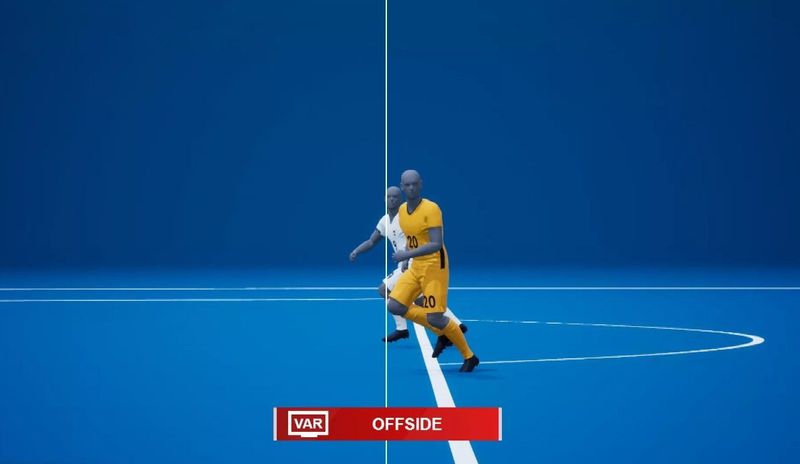
Semi-Automated Offside Technology is applied in FIFA World Cup 2022
Advancements in technology have paved the way for semi-automated offside systems that provide real-time information to referees. These systems use computer vision and artificial intelligence algorithms to track players' positions, flag potential offside situations, and assist referees in making accurate decisions. Implementing such technology could further enhance the precision and efficiency of offside calls.
Revised Offside Definition
The offside rule's complexity and subjectivity have led to debates about its interpretation. Football authorities may consider refining the definition of offside to provide more clarity and reduce contentious situations. This could involve reevaluating aspects such as the timing of the pass, the position of the players, or introducing a margin of error to minimize marginal offside decisions.
Instantaneous Offside Decisions
To minimize disruptions to the game, future developments may focus on making offside decisions instantaneous. By utilizing real-time tracking technology and integrating it with the referee's communication devices, officials could receive immediate alerts regarding what is the offside in football, allowing for seamless decision-making without interrupting the flow of play.
VAR Protocol Standardization
The introduction of VAR has brought both benefits and challenges to the implementation of the offside rule. To ensure consistency and eliminate confusion, football authorities could work towards standardizing the VAR protocol for offside decisions across different leagues and competitions. This would reduce discrepancies and promote uniformity in how the rule is applied.
FAQs - What is offside in football?
- The offside rule in football ensures fairness and balance in football matches by preventing attacking players from gaining an unfair advantage. It encourages more strategic gameplay and tactical approaches from both teams.
- No, there are no specific distances mentioned in the rules "what is offside football". It is solely based on the positions of the attacking player, the second-to-last defender, and the ball when it is played.
- Yes, a player can be in an offside position without interfering with play. If the player does not gain an advantage or participate actively in the play, the offside offense is not called.
- No, an offside offense results in an indirect free-kick for the defending team from the spot where the offside occurred. Only fouls committed within the penalty area lead to direct penalty kicks.
- Yes, the offside rule is universally applied across football leagues worldwide. However, there may be slight variations in interpretation and implementation based on the specific rules of each league or competition.
- VAR stands for Video Assistant Referee, which is a technology-based system used in football to review critical incidents and help officials make more accurate decisions.
- While VAR aims to reduce errors in offside decisions, there is still an element of interpretation involved, leading to occasional controversies and debates.
- VAR can cause delays and disruptions as officials review incidents, leading to potential interruptions in the flow of the game. Efforts are being made to minimize these disruptions.
- Influential cases, such as the "Geoff Hurst's Goal" in the 1966 FIFA World Cup final and the disallowed goal in the 2004 Barcelona vs. Chelsea match, have sparked debates and discussions about the interpretation of the offside rule, leading to revisions and refinements.
- No, the offside rule in football only applies to the attacking half of the pitch. A player cannot be in an offside position in their own half.
Related Content
